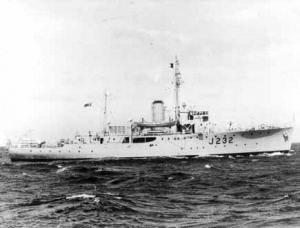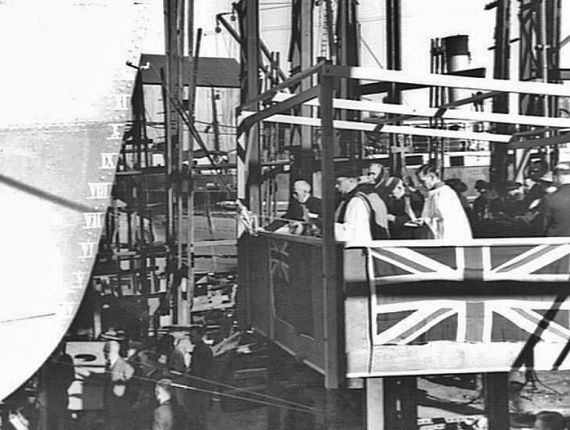HMAS Deloraine
| Class |
Bathurst Class |
|---|---|
| Type |
Australian Minesweeper |
| Pennant |
J232 |
| Builder |
Mort's Dock and Engineering Co Ltd, Sydney |
| Laid Down |
19 March 1941 |
| Launched |
26 July 1941 |
| Launched by |
Dame Mary Hughes, wife of the Minister for the Navy |
| Commissioned |
22 November 1941 |
| Decommissioned |
30 June 1948 |
| Dimensions & Displacement | |
| Displacement | 650 tons |
| Length | 186 feet |
| Beam | 31 feet |
| Draught | 8 feet 6 inches |
| Performance | |
| Speed | 15 knots |
| Complement | |
| Crew | 85 |
| Propulsion | |
| Machinery | Triple expansion, 2 shafts |
| Horsepower | 2000 |
| Awards | |
| Battle Honours | |

HMAS Deloraine was one of sixty Australian Minesweepers (commonly known as corvettes) built during World War II in Australian shipyards as part of the Commonwealth Government's wartime shipbuilding programme. Twenty were built on Admiralty order but manned and commissioned by the Royal Australian Navy. Thirty six (including Deloraine) were built for the Royal Australian Navy and four for the Royal Indian Navy.
HMAS Deloraine was laid down at Morts Dock Engineering Company, Balmain, Sydney, NSW on 19 March 1941. She was launched on 26 July 1941 by Dame Mary Hughes, wife of the Minister for the Navy and was the first RAN warship to carry the name of the town on the Meander River in the central north of Tasmania. By the war's end Mort's Dock had constructed fourteen of the sixty Bathurst Class corvettes.
Deloraine commissioned at Sydney on 22 November 1941 under the command of Lieutenant Commander Desmond A Menlove RANR(S).
On 26 December 1941 Deloraine sailed from Sydney for Darwin to begin her active operational career with a period of anti-submarine patrol duty in the Arafura Sea.
She arrived at Darwin on 7 January and began duty protecting the harbour approaches. The first few days proved uneventful, though Japanese submarines were suspected of being in the area. Events, however, proved the suspicion to be well founded for at noon on 20 January Deloraine, then at sea off Darwin, received a signal 'proceed forthwith to position 12°08´ south, 130°10´ east, for submarine sighted 06:30 today Tuesday'. At 14½ knots she proceeded as ordered.
Earlier the same day a Japanese submarine had been detected and attacked by the American destroyer USS Edsall, but it was not known if she had succeeded in inflicting damage. It was hoped Deloraine would regain contact on the given course. At 13:35 a torpedo was seen approaching, the ship swung sharply and it passed ten feet astern.
Immediately a good echo contact was obtained and within a matter of minutes the minesweeper dropped a pattern of six depth charges. Large patches of oil and great air bubbles burst to the surface. The attack continued and after Deloraine had expended all of her charges, she was joined by her two sister ships HMAS Katoomba and HMAS Lithgow, before departing to reload with depth charges from HMAS Vigilant.
Returning to rejoin Katoomba in the early hours of the following morning, Deloraine obtained a second contact and dropped a further series of charges over the position. Post war investigation of Japanese records showed that the first attack had been successful, and Deloraine, Katoomba, Lithgow and Edsall were officially credited with destroying the Japanese submarine I-124. A vessel of 1,142 tons, she was one of the only four minelaying submarines in the Japanese Navy and loaded forty-two mines and twelve torpedoes. I-124 was the first enemy submarine sunk in Australian waters. On 28 June 1977 the Minister for Administrative Services signed a declaration under the Historic Shipwrecks Act 1976, establishing the remains of I-124 as an historic shipwreck.
In February 1942 Deloraine began a period of escort and anti-submarine duty between Darwin and Thursday Island, which lasted until June. She was berthed in Darwin Harbour when the first Japanese air raid took place on 19 February 1942. Fortunately she suffered no damage and was able to render valuable assistance with rescue operations. On 5 March, on anti-submarine patrol off Darwin, she was attacked three times by a Japanese four engined flying boat, but again emerged unscathed.
In July 1942 Deloraine returned to Sydney to begin convoy escort duties on the east coast and to forward areas. The midget submarine attack on Sydney Harbour was a recent event, and three ships had been sunk off New South Wales the previous month. For the next twenty months, except for brief periods in dockyard hands, the ship was in constant service protecting the coastal shipping moving between Sydney, Newcastle, Brisbane and New Guinea.
In April 1943 she rescued nineteen survivors of the torpedoed United States merchant ship Lydia M Child. Of the many hundreds of ships safely shepherded into port only two were lost in convoy. Both were torpedoed off the New South Wales coast on 16 June 1943 - the United States merchant ship Portmar and the landing ship LST 469.
In May 1944 Deloraine took up station in the New Guinea area for escort, patrol and troop carrying duties, including support of the operations at Noemfoor, Biak and Morotai.
In February 1945 she carried out bombardments of Japanese positions on Bass and Penguin Islands in the Mapia group. Further assaults on enemy shore posts followed in April against Muschu and Kairiru Islands and Wewak on the New Guinea mainland. On the last day of April 1945 she sailed from Langemak for Brisbane to be refitted. Hostilities ended before the work was completed.
In September 1945 Deloraine proceeded to Morotai where she embarked troops for the occupation of Menado in the Celebes, returning to Australia in November after visiting Labuan and Sandakan Harbour. The end of the year found her sweeping on the New South Wales coast.
In 1946 she was employed on minesweeping operations in the New Britain area as a unit of the 20th Minesweeping Flotilla, returning to Sydney on 13 July. The ship paid off into Reserve at Sydney on 4 November 1946.
On 16 December 1946 Deloraine recommissioned at Sydney for further service as a unit of the 20th Minesweeping Flotilla. She remained on active seagoing service assisting in the post war mine clearance programme until January 1948, when she arrived at Fremantle to pay off. She had then steamed some 166,000 miles of which 129,000 miles were steamed on active service in World War II.
Deloraine paid off into Reserve at Fremantle on 30 June 1948. She was sold to the Delta Shipping Co Ltd, Hong Kong, on 8 August 1956 for breaking up.
Note: This video is hosted on YouTube. Department of Defence users will not be able to view this video on the Defence Protected Network.
This cine film has been placed online as part of the Sea Power Centre - Australia's ongoing archival digitisation program.
Further reading
- 'Notable Service to the Empire: Australian Corvettes and the British Pacific Fleet, 1944-45' by Hugh Campbell - published by Naval Historical Society of Australia Inc, Garden Island, 1995.
- 'The Corvettes: Forgotten Ships of the Royal Australian Navy' by Iris Nesdale- published by the author, October, 1982.
- 'Corvettes - Little Ships for Big Men' by Frank B Walker - published by Kingfisher Press, NSW, 1996.
- 'The Australian Centenary History of Defence Volume III, The Royal Australian Navy' edited by David Stevens, Oxford University Press, South Melbourne, Victoria, Australia, 2001.



















